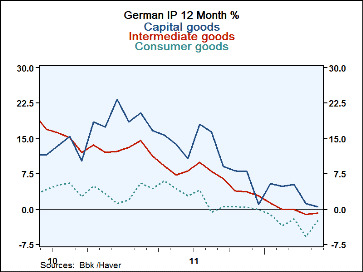 Global| Jul 06 2012
Global| Jul 06 2012German IP Shows Unexpected Life
Summary
German output and orders have shown unexpected life in May. While the problems in EMU continue to swirl around it and Germany seems to be caught in the outermost grip of the spiral we have this month had at least two reports that defy [...]
 German output and orders have shown unexpected life in May. While the problems in EMU continue to swirl around it and Germany seems to be caught in the outermost grip of the spiral we have this month had at least two reports that defy the notion that weakness in the Zone is dragging Germany down. The industrial orders report whose headline is memorialized in the table joins the industrial output report in being renegade to the concept of an entangled German economic machine.
German output and orders have shown unexpected life in May. While the problems in EMU continue to swirl around it and Germany seems to be caught in the outermost grip of the spiral we have this month had at least two reports that defy the notion that weakness in the Zone is dragging Germany down. The industrial orders report whose headline is memorialized in the table joins the industrial output report in being renegade to the concept of an entangled German economic machine.
German industrial production rose by 1.6% in May after fall in April. Its sequential rates of growth show that IP is gain momentum and the orders profile supports that hard-to-believe pattern. As with orders, consumer goods are leading the way higher. As with orders capital goods trends are showing a decaying profile. Capital goods is usually the leading sector in the German economy. The construction sector has been making a particularly strong if erratic set of gains recently.
Meanwhile, the global growth environment remains impaired. Central banks around the globe are joining en mass to provide further liquidity and or to cut rates. The BOE the ECB and the Bank of China each made moves yesterday. The Federal Reserve previously announced that it would extend its set-to-expire Operation Twist. The IMF announced today that it is cutting its outlook. Economic conditions are not getting better.
German output may be benefiting from some domestic construction boom. But its orders jumped in May on the strength of foreign orders at a time when the German economy looks be the strongest place in Europe and when the regions outside German borders, particularly in Europe itself, have looked beleaguered. This ‘revival’ might make more sense if the source of order strength were in a resilient German economy itself but that is not the case according to the orders data which find domestic orders contracting and the strength abroad. (One caveat there is that there is a construction spike). I remain skeptical of the durability of this unexpected strength.
| Total German IP | May-12 | Apr-12 | Mar-12 | 3-mo | 6-mo | 12-mo | Quarter-to-Date |
|---|---|---|---|---|---|---|---|
| IP Total | 1.6% | -2.1% | 2.2% | 6.7% | -0.2% | 0.0% | -0.3% |
| Consumer | 3.8% | -3.4% | 2.2% | 10.3% | 0.2% | -2.5% | -2.5% |
| Capital | 1.7% | -3.7% | 1.6% | -2.0% | -0.3% | 0.5% | -7.2% |
| Intermediate | 1.0% | -0.3% | 0.2% | 3.5% | -0.3% | -0.8% | 1.5% |
| memo: | |||||||
| Construction | 3.1% | -5.5% | 26.0% | 126.6% | 1.1% | 2.2% | 26.1% |
| MFG IP | 1.9% | -2.3% | 1.1% | 2.5% | 0.2% | -0.3% | -2.7% |
| Real MFG Orders | 0.6% | -1.4% | 0.0% | 9.1% | 4.2% | -5.4% | 5.1% |
Robert Brusca
AuthorMore in Author Profile »Robert A. Brusca is Chief Economist of Fact and Opinion Economics, a consulting firm he founded in Manhattan. He has been an economist on Wall Street for over 25 years. He has visited central banking and large institutional clients in over 30 countries in his career as an economist. Mr. Brusca was a Divisional Research Chief at the Federal Reserve Bank of NY (Chief of the International Financial markets Division), a Fed Watcher at Irving Trust and Chief Economist at Nikko Securities International. He is widely quoted and appears in various media. Mr. Brusca holds an MA and Ph.D. in economics from Michigan State University and a BA in Economics from the University of Michigan. His research pursues his strong interests in non aligned policy economics as well as international economics. FAO Economics’ research targets investors to assist them in making better investment decisions in stocks, bonds and in a variety of international assets. The company does not manage money and has no conflicts in giving economic advice.






